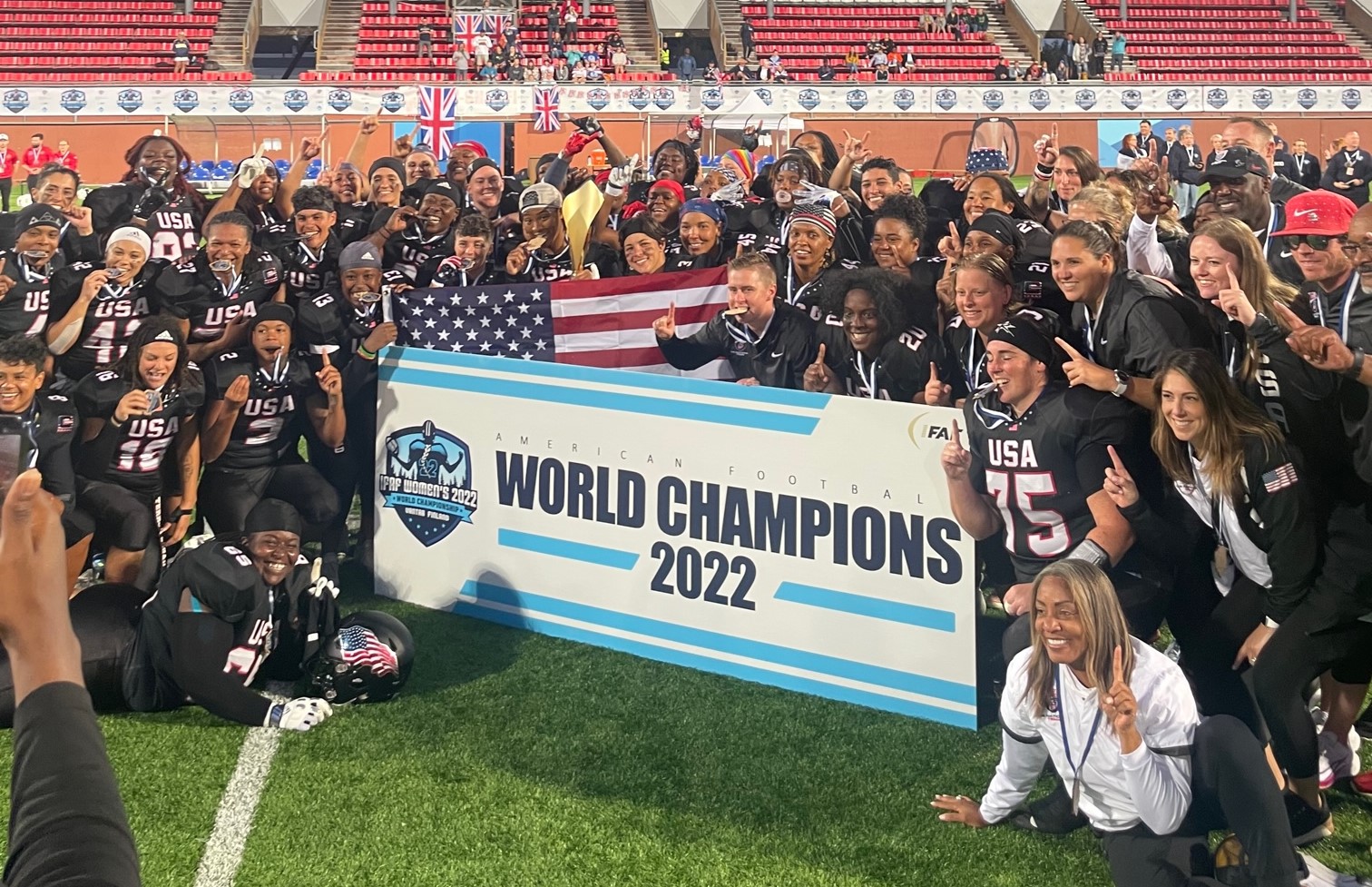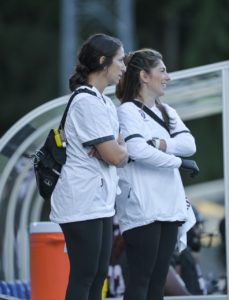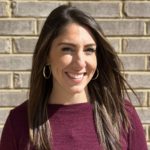
A Golden International Experience: USA
Football
Working in the medical field can open up many amazing opportunities that can bring you to some wonderful places where you can meet incredible people. I never thought in my wildest dreams that it would bring me to Finland with a women’s tackle football team where I would meet about 50 of the most inspirational women I’ve ever worked with.
This past summer I had the pleasure of representing Team USA and University PT at the Women’s Tackle Football World Championships in Vantaa, Finland as the team physical therapist/athletic trainer. Yes, I said WOMEN’S tackle football. No, not flag football. Tackle. Full pads and helmets. College rules American Football. Eight countries were represented. Along with the US, Canada, England, Germany, Australia, Finland, Mexico, and Sweden all sent teams to Vantaa.
Before I was asked to take part in this event, I had no idea women’s tackle football even existed. I’ve come to find out that there are two leagues in the USA – The Women’s National Football Conference (WNFC) and the Women’s Football Alliance (WFA). The WFA has even expanded internationally. Each league starts play in April and ends in July with a national championship. Team USA was made up of 45 women from both of these leagues. The Head Coach was Callie Brownson, who is Chief of Staff of the Cleveland Browns, the first woman in NFL history to coach a position group, and an overall remarkable person. The passion and commitment these women had for this sport was nothing short of inspirational. The passion they have for a sport that barely has a platform for them is truly moving.
I’ve worked on the sidelines before, but this experience was uncharted territory. I’ve never worked football. I’ve never worked for a national team. I’ve never even been to a country where English wasn’t the primary language! Getting on the plane wasn’t as nerve wracking as getting off the plane where I was immediately thrown into two-a-day practices and responsible for 45 players’ medical care completely on my own. (Luckily, the second athletic trainer, my friend Trisha, arrived on day 3.) To make matters more challenging, I hadn’t actually practiced as an athletic trainer in 8 years. I’d been at physical therapy school and then practicing as a PT. For those that don’t know, they are related professions but have very different skill sets and responsibilities. Both professions carry out rehabilitation programs, but athletic trainers are responsible for sideline care, emergency care, on-field injury management and pre-/post-practice care including taping, wrapping, wound care, hydration, nutrition, among others.
Training camp was at Walsh University in Canton, Ohio and lasted for 7 days. The days were strictly scheduled 12 hour days with late nights and early mornings. We transformed a dorm room into an athletic training room/physical therapy clinic. It definitely tested my physical and mental capacity as these were long days out in the heat and sun that I was not used to, and I wasn’t even out there practicing in full football pads. Needless to say, the week got to everyone. We were all tired going into the dreaded third day of training camp. If you’re involved in sports at all, you know the third day of training camp is always the day that things happen. Unfortunately that theory proved true as we had a linebacker tear her ACL and a wide receiver fracture and dislocate her finger that day. Just to add to our third-day excitement, a small tornado chose to roll through campus that night too. We were forced to hide out in bathtubs on the first floor of the dorm halls until it passed. Although the week was challenging for all of us, we bonded over that and became a family – just in time to leave for Finland.
We got to Finland on July 28 and went right to the field to practice from the plane. My first impression of Finland was that it was very green, flat, and the air was crisp and clean. I remember thinking that if every day was like this, then I wanted to be outside every minute of the day. Our days were less structured than they were in training camp, but each day carried a little more weight since our first game against Germany was quickly approaching. I started sitting in on team meetings to get the full effect of what the athletes were going through. It was great listening and learning from Head Coach Callie Brownson who spoke meaningful lessons to her team, forming her messages around the mindset of the New Zealand rugby team, the All Blacks. Since Team USA was the 3-time defending champion, it seemed that other teams had it out for us. We had the worst practice times, got assigned the smallest hotel rooms and when every other team was fed varieties of salmon, steak, and duck, we had pasta with chicken every single day. Callie’s message was that we didn’t need those things to be a championship team because the “All Blacks take care of themselves”.
They practiced every day and Trish and I did player treatments 2-3 times a day to prevent injury and keep the team healthy leading into competition. Our small hotel room was flooded with players every day and night and it seemed like our waiting list never ended. From sitting on Normatec recovery boots to being dry needled to performing rehab exercise programs, we did all the treatments in our small hotel room. The “athletic training room” quickly became the late night team hang out which kept me and Trisha energized and entertained enough to complete our treatments.
Managing injuries in this setting was challenging as we did not have a team physician, had limited access to medical resources (i.e. x-rays, MRIs, urgent care, medications) and were dealing with foreign differences in medical care systems. For example, Finland does not utilize ice as much as we do in America so our ice bags were made with the excess “snow” that was taken from the Zamboni on the ice hockey rink next door. Although medical resources were limited, communication with coaches was plentiful. We had nightly meetings where I would update the coaching staff on team injuries and develop specific practice and game day plans for each. Although I work in sports medicine regularly, communication with coaches can be limited since I work in a clinic and not on the field at practice every day. These meetings were so important in maintaining the health of the team and the coaching staff couldn’t have been easier to work with in this regard. It was refreshing to work with a group of coaches who understood and cared about the longevity of their players’ health and trusted us to do our jobs.
We breezed past Germany in the first game, winning 62-0. The second game three days later was against Finland who gave us a run for our money in the first half. Fortunately we came back and defeated them 28-10. Game days looked a little different in that we slept in a little bit, did morning treatments at the hotel, had meetings and then transitioned all the equipment from our hotel training room to make an on-field training room. We had 30 minutes to wrap, tape, stretch and do any wound care needed for 45 women. Needless to say we were working at light speed. During the game we stayed on the sideline and tended to any injuries or wounds that occurred during the game. Proudly donning our fanny packs full of tape and wound care supplies, we constantly paced up and down the sidelines checking in on all the position groups. If you’ve ever been on the sidelines of a football field it is chaotic! If you’re holding someone out for assessment, you have to first determine what position they play, indicate which coach is their position coach and then activate a messenger system to deliver the news. Chaos.
Luckily throughout the first two games there were just minor bumps and bruises and a little bit of blood. We were heading into the gold medal game with a full roster of 45. Callie Brownson played in this tournament in 2013 and 2017. She said the team had never gone into the gold medal game with a full roster. She credited a lot of that to the medical care that Trisha and I had been providing her players for the last 2 weeks. It was pretty awesome to hear that and see the pay off from all the hours of work we had been putting in for these women. I was proud of us.
During the gold medal game, we stayed pretty healthy. Unfortunately we had to sideline one of the defensive backs due to concussive symptoms. She had a pretty extensive history of concussions so we wanted to err on the side of caution. We were winning with just about 2 minutes left in the game when a player from Great Britain had a late tackle on one of our players. Our player hobbled off to the side and because of a palpable deformity and positive Ottawa Ankle Rules, we determined she likely had a fibular fracture. Well here’s the thing….We were about to beat Great Britain and planned to celebrate after the game. We were scheduled to leave Finland the very next morning. We had no idea how to navigate the Finnish medical system. Luckily we had a walking boot and since the fibula only bears 15-20% of your bodyweight and is not a medical emergency when broken, we gave the athlete a choice. She could either wait in the emergency room for a few hours for evaluation and imaging and miss the celebration or we could give her the walking boot, manage her pain, wrap her up for the plane ride and let her go celebrate. What do you think she chose? So we picked her up and carried her onto the field when the time ran down to zero. We had beat Great Britain 42-14 for the gold medal! I have never been in a locker room to celebrate a championship win but I’ve seen plenty on ESPN. It’s exactly how I imagined. Champagne, yelling, hugging, cheering, chanting. And the cherry on top was getting a gold medal hung around my neck. One of the coolest things I’ve been a part of.
We later learned that the woman who tore her ACL also had a bucket handle tear of her meniscus and had surgery within a couple weeks of us returning to the US. The woman who broke her fibula also displaced it and she went in for surgery within a week of getting home. Lastly the woman who broke and dislocated her finger played through the tournament and had surgery in September. All have reached out to me and thanked me for getting them through the tournament. I’m still in touch with them today.
I didn’t know what I was getting myself into when I said yes to this experience. Little did I know how much of an impact these women would have on my life and how wonderful it would be to share my skills and knowledge in such a different way than I do on a daily basis. I have trouble putting into words what this experience was like when people have asked me. You just had to be there to feel it. All the passion, love, respect, gratitude, ambition, and sacrifice. The way that I was taken in as part of the family eased the fact that I terribly missed my home and husband. Don’t get me wrong, winning a gold medal was pretty cool, but these lifetime connections and friendships I’ve made will live on my heart forever. It was a privilege to share my knowledge and skills with this team and an honor to stand beside them. I’m a women’s tackle football fan for life.


